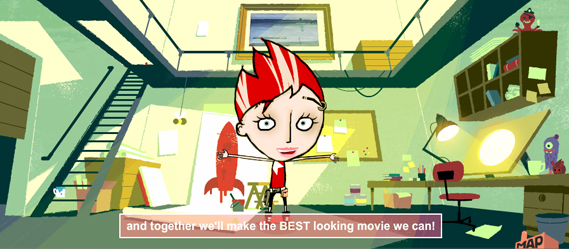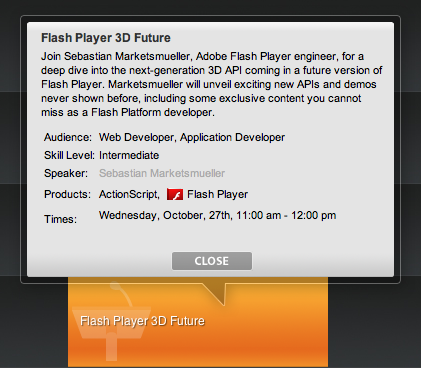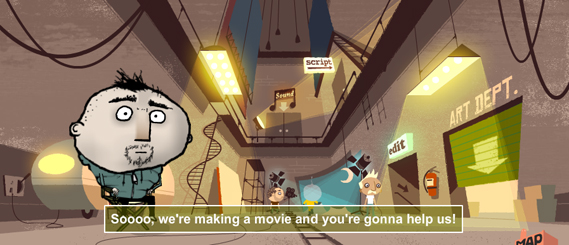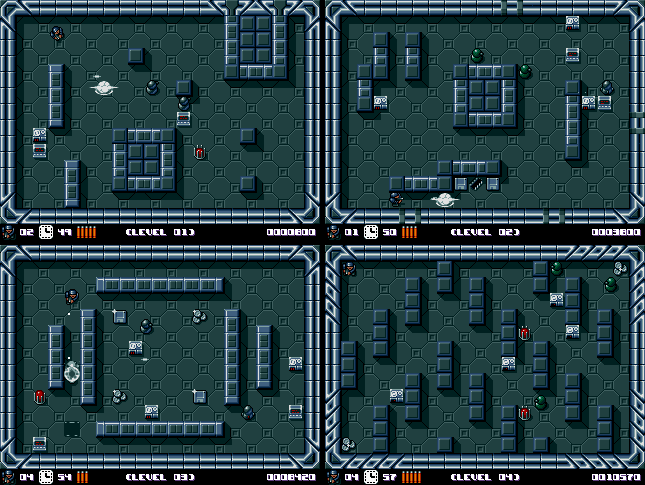Author Archive
-
The Tate Movie Project goes live
15th Jul 20101Today Aardman Digital (where I’m Technical Lead) put live one of the biggest site builds we’ve done yet. Called the Tate Movie Project, it’s all about children getting involved in the creation of a film, which will be shown on the BBC next year. They can create assets online using a suite of tools we’ve built, or visit one of the tour buses currently going around the UK, where they get real hands on experience of the film making process. Ultimately children will have created the bulk of the visuals used in the final film.
Due to other projects I didn’t contribute a great deal of coding personally, but the Sound Tool (which you can find in the Sound Studio part of the site) is mine! This is where the children can record themselves, apply special effects, and submit their creations to the film. I built the tool several months ago, knowing that the release of Flash Player 10.1 was imminent. I wanted to use 10.1 as it allowed us to get real-time access to the Microphone, and then apply special effects without the need for a media server back-end. However we also had to create an FMS version for users running older versions of Flash Player! So the site switches between the two tools based on your player. Thankfully Adobe released Flash Player 10.1 final a few weeks before launch. It will be interesting to see the change in traffic to our FMS servers as users migrate over to 10.1.
The other tools include the Script editor, an Animation tool and an area to upload your images for the film. The tools are aimed at 5 to 13 year old children, which is a very wide spectrum in terms of technical capability. We ran a lot of user testing sessions in schools, gauging how the children worked with the tools and tweaking them accordingly – so although they may seem a bit primitive to most readers of my blog, we know they’re bang-on for the target audience.
There are also loads of hidden features across the studio: for example when the director is talking you could try clicking the lights in the background, bang the spot lights with your mouse, drag down light switches, pull down the ladder and many more. In the Script room turn the fan on, then click on the paper that falls to the floor, then bounce it off your mouse cursor into the bin. In the music studio knock musical notes out of the composers head, drag them onto the wall, and play your tune! An awful lot of love and care went into the smallest details, all of which are aimed at rewarding kids natural curiosity.

It was an extremely exciting project to be involved with, using a lot of talented people. The bulk of Flash development was handled by Tom Milner, our resident Flash guru. With animations coming in from two of the best Flash animators out there: Robin Davey and Felix Massie. Awesome thanks also go to a big roster of Bristol’s finest web development talent including Craig Francis, Rick Hurst, James Spencer and Julian Guy, all of whom are superb and strongly recommended if you’re in need of site build ninjas.
We first began work on the site almost 2 years ago, when myself and Dan Efergan (our Creative Director) spent a long time coming up with the “virtual studio” concept, how the tools would work and interact together, and how the progression of the film production would be displayed (keeping the children interested for what is a year long process). So Tom and the other developers can blame a lot of the frantic deadline chomping work they had to do on us 🙂 But it was all worth it. The site is lovely to interact with. And the biggest kick of all is actually watching children use it. It truly makes it all worth while.
There’s a brilliant piece on the site over on Creative Review.
If you are in the UK (and have kids who are the right age for this) then I urge you to let them take part, or maybe visit the Tour Bus. Also keep an eye on Blue Peter and Newsround on CBBC.
-
Robotz DX – A PC Remake of the Atari ST classic
9th Jul 2010A long time ago I announced that I wanted to do a remake of a classic Atari ST game “Robotz” in Flash. Fast forward to today, and I still haven’t got around to it. However James Monkman (Heavy Stylus of RGCD) wasn’t as lazy as me, and set about creating this awesome re-imaging of the original.
Although it’s for Windows PCs only (as it was created in Game Maker 8) it’s a mighty fine game indeed! A lot of the limitations of the original have been removed, and the gameplay is faster, more frantic and basically more fun as a result. Check out this cool video to see what I mean:
The graphics are lovely, a faithful blend of rips from the ST original and some new pixel art. 505, Crazy_Q and Damo provide the stomping soundtrack.
If you remember the original, you’ve got to try this version of it.
Hell, if you just enjoy quality games – you’ve got to try Robotz DX 🙂
Loads more info and the download here: http://www.rgcd.co.uk/robotzdx/
-
@thibault_imbert drops a Flash 3D teaser bomb
7th Jul 2010
A few days ago Twitter exploded when someone noticed in the Adobe Max 2010 schedule a session called “Flash Player 3D Future”. Today Thibault Imbert (Product Manager for Adobe Flash Player) put up this blog post, teasing more on the subject:
“Now you may wonder, what does this means, what kind of 3D are we talking about ?
What kind of API ? True textured z-buffered triangles ? GPU acceleration ? Even better ? What I can say is forget what you have seen before, it is going to be big 🙂
When this will be available ?
We will share plans with you at Max during this session, I tell you, some serious stuff is coming for 3D developers.”
The key part of his post is “GPU acceleration”. The software renderer inside of Flash has long been its bottleneck. It is what stops Flash being a serious contender in the desktop gaming market. It is what makes Unity developers look at AS3 3D libraries and roll their eyes. It is what makes the limit on the amount of pixels we can push around so incredibly tiny, in comparison to what even low-end GPUs can do these days. Equally screen resolutions are constantly increasing, but still we have to cram our games into small areas because performance just isn’t good enough.
Most old-time Flash developers (hey Squize) don’t expect Adobe to announce anything useful. “It’ll be some half arsed gpu acceleration, only available if you set the wmode in the html, or something equally useless”, “does anyone remember the physics demo they showed last year? that never made it either”.
Adobe have a lot to live up to from previous Max hyperbole.
I’m slightly more optimistic, but I can appreciate their scepticism. Having been playing with Chrome’s HTML5/WebGL support a lot these past few weeks, I truly believe this is Adobe’s only shot at succeeding in the 3D web space. Because time is running out for them. GPU acceleration is going to have to work across the board, and accelerate all graphical elements: bitmap, vector, 3D. A cherry on the cake? Allow PixelBender shaders to run on the GPU too.
It’s about time they truly supported Flash game developers. This would be a significant step forward. It would open the desktop games market to us, it would allow proper 3D games to be made in Flash, and it has the opportunity to give an incredible speed boost to all of graphics operations in Flash.
Don’t drop the ball on this one Adobe. I beg of you.
Read the full blog entry here: http://www.bytearray.org/?p=1836
-
10 things I took away from The Children’s Media Conference
6th Jul 2010
Last week I attended the Children’s Media Conference with lots of other people from Aardman. It was a 3 day mix of presentations, panels and meeting really interesting people. And everyone there had something to do with the children’s side of the media and entertainment industry. I just wanted to share a few insights that I picked up there. Some are obvious, some less so …
1.) Children are no longer just watching TV, they expect to interact with it. On their phones, via MSN, on YouTube, etc. And often do these things simultaneously (watching a show while chatting to friends about it). The distinction between TV and online is a non-plus for them. They have an extremely rich media diet.
2.) Traditional broadcasters (and “offline” producers) are increasingly worried they are taking too long to resolve the provision of content. And children are just going online instead. The world is changing faster than a lot of them can cope with.
3.) Children prefer “home grown” material – i.e. they don’t want to hear American voices in their cartoons. The same applies to games, only to a much lesser extent.
4.) Broadcasters recognise that the future is on-demand, and in the long term, online. The BBC specifically made a point that they were perfectly aware that digital is the future.
5.) Lots of Children love manga! (no surprise there) The style of artwork allows them to clearly see the emotions that the characters are experiencing. And manga / anime characters do actually show emotion, unlike most US made cartoons in the same area. They find the super powers and stories generally more exciting, and want to be part of that fantasy. There is a really strong “collect, compete, play” association with most popular manga/anime (think Pokemon, Yui Gi Oh or Bakugan). Manga/Anime is less concerned about dealing with emotion and more complex subjects.
6.) “Transmedia” is now what they are calling the latest iteration of “new media”. But it’s all just media really. Transmedia (like before it) is just the means of telling or experiencing a story across multiple platforms.
7.) “Games Bibles” are vital, no matter what scale game you are working on. Matt Costello gave a brilliant (although sadly very brief) talk about how he created the game bibles for games like Doom 3 and Just Cause 2. They should start off as a paragraph, explaining the concept behind the world in which the game lives. And then expand from there, eventually encompassing as much detail as possible in order to bring the game alive. Bibles shouldn’t just focus on the game itself, but look into the backstory and what could happen in the future, should the series run or adapt across to a different media (game made into a TV show or comic for example).
8.) Girl Gamers: Girls love tech! They adopt it way ahead of boys. By 8 years old most of them will own a gaming device (like a DS), by 10 lots will have a mobile phone of their own and a laptop/PC. By 11 they’ll have Facebook accounts (and boys will have XBLA accounts). By 13 most have personal iTunes accounts or equivalent. Between the ages of 9-10 is when most girls peak at their interest of gaming. They are competently using online services (for social and gaming aspects) and use of their mobile is massive. Age 10+ and they mostly now focus on social spaces and social networking. To them Facebook IS a game. Creating private worlds is key, the ability to build a social space away from their home.
9) Games that can tick the following subject boxes appeal strongly to girls aged 10-13: Manipulation (!), Relationships (Sims), Problem Solving (puzzles), Responsibility (pet games), Private Worlds, Role Playing (Imagine Teacher), Identity, Risk Taking. In reality most games fail to keep their long-term interest. A quote from a 10 year old: “I classify my phone and my laptop as my toys”. The Blackberry mobile phone is huge for girls and is often their top “most desired” item. This is due to the social nature / features it provides (Blackberry messenger). Social networking for them becomes obsessive around age 12. By age 13 they want cues from the real world in their games.
10) Graphic Novels and Comics are making a huge come-back for children, and are no longer mostly for adults! Publishers like Walker Books are reporting sales up by 29% over the previous year. They are finally coming “back to kids” – picture books aimed at 8-9 year olds (such as Savage by David Almond) are breaking new ground. Visual literacy is just as important as reading ability. Jamie Smart gave a brilliant talk about how he can release a new comic strip on his web site, and earn a decent living from the merchandise surrounding it. The team at Pulp Theatre are releasing graphic novels through their Alien Ink range, aimed at teenagers and issues they find hard to talk about. Has been a huge success, now sponsored by Channel 4. Again they did the whole range of releasing online and on Facebook before going into print form. They took the comics to where the kids hang out, they didn’t expect them to “come find them”.
Please bear in mind that figures given should be taken in the context in which they were delivered (i.e. are probably only relevant to the UK)
Despite the heat wave it was a great conference. And interesting to see how other people are applying the same kinds of professional skills that we have (from web development to game design) and applying those to entertaining and educating children. Perhaps even yours? 🙂
-
Decades album by 4mat is out now
5th Jul 2010Matt Simmonds is something of a legend in the Amiga/demoscene world. Under the pseudonym “4mat” he composed hundreds of famous music tracks for cracktros, demos and games. You can find over 500 of them on the Amiga Music Preservation site. MobyGames also keeps a relatively accurate list of his commercial and freeware audio work.
Today he released his album “Decades”. All of the 14 tracks on the album were created using the same tools he had available “back in the day”, namely ProTracker and FastTracker 2. I just bought the album from Amazon after having a listen on-line, and I’m really pleased at the mix of styles and raw chip sound that shines through. Some tracks carry better than others, but my personal favourite has to be “Virginia”. You can listen to the tracks below:
Read more about its production on Matt’s blog: I Hear the Sound of Waves. There is also a great interview with him on IndieGames.com. And if like me, you really enjoy what you hear, then Amazon MP3 has the goods.
Fellow Photon Stormer Ilija was saying just the other day that Matt has been in contact with him quite a bit recently. Perhaps a graphic/audio collab is on the cards? We’ll keep you posted … and Matt, if you’re up for it, we certainly have a couple of games we’d love to have your audio input on 🙂
Hire Us
All about Photon Storm and our
HTML5 game development services
Recent Posts
OurGames
Filter our Content
- ActionScript3
- Art
- Cool Links
- Demoscene
- Flash Game Dev Tips
- Game Development
- Gaming
- Geek Shopping
- HTML5
- In the Media
- Phaser
- Phaser 3
- Projects
Brain Food





